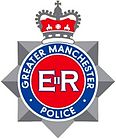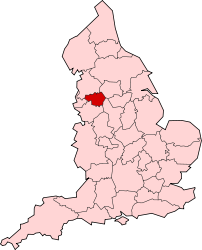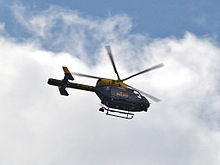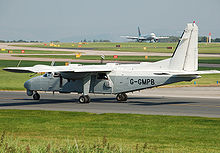- Greater Manchester Police
-
Greater Manchester Police Abbreviation GMP Badge of the Greater Manchester Police. Motto Fighting Crime, Protecting People Agency overview Formed 1974 Preceding agency Metropolitan Manchester City Police (circa 1830s to 1842)
Manchester Borough Police (1842-53)
Manchester City Police (1853-1968)
Manchester and Salford Police (1968-74)Employees 12,526[1] Volunteers 350[1] Annual budget £524.1 million[1] Legal personality Governmental: Government agency Jurisdictional structure Operations jurisdiction* Police area of Greater Manchester in the country of England, UK Map of Greater Manchester Police area Size 492 square miles (1,300 km2) Population Approx. 2.5 million Legal jurisdiction England & Wales Governing body Greater Manchester Police Authority Constituting instrument Police Act 1996 General nature Operational structure Headquarters Chester House, Manchester Constables 8,384 (of which 350 are special constables)[1] Police Community Support Officers 773[1] Agency executives - Peter Fahy, Chief Constable
- Garry Shewan, Assistant Chief Constable
Child agency Tactical Vehicle Crime Unit
Manchester Ship Canal Police (1893-1993)
Manchester Airport Police (1954-1976)Divisions 12 Stations 62 Facilities Panda cars Ford Focus
Vauxhall AstraPursuit vehicles Vauxhall Vectra C
Volvo S60
BMW 3 Series
BMW 5 SeriesPatrol vehicles Range Rover
Volvo V70
BMW X5Helicopters India 99
MD Explorer (1)Planes India 66
Britten-Norman Defender (1)Website www.gmp.police.uk Footnotes * Police area agency: Prescribed geographic area in the country, over which the agency has usual operational jurisdiction. Greater Manchester Police (often abbreviated as GMP) is the police force responsible for law enforcement within the metropolitan county of Greater Manchester in North West England. GMP are the largest police force after the Metropolitan Police Service.
In total, Greater Manchester Police employs; 8,232 police officers, 332 Volunteer Special Constables, 782 Police Community Support Officers, and 4,068 members of police staff. The GMP headquarters are at Chester House, Old Trafford.
Contents
History
Greater Manchester Police had its early origins in the Metropolitan Manchester City Police which formed sometime in the 1830s, just after the Metropolitan Police Force in London. The force than changed its name to Manchester Borough Police, presumably to differentiate itself from its Metropolitan London counterpart. Upon Manchester gaining city status in 1853, the police force then changed its name again to Manchester City Police to reflect this status. The name of Manchester City Police remained for over a century until 1968 when Salford City Police was merged in Manchester City Police, resulting in the new name of Manchester and Salford Police. Then in 1974, in accordance with the Local Government Act 1972, Greater Manchester Police was formed with parts of the Cheshire Constabulary and Lancashire Constabulary merged into GMP.
The force was formed in 1974 by the amalgamation of Manchester and Salford Police with parts of Lancashire Constabulary, Cheshire Constabulary and West Yorkshire Constabulary. The first Chief Constable of the force was William James Richards, followed shortly afterwards, in 1975 by James Anderton. In 1993 David Wilmot succeeded James Anderton. In 2002 Michael Todd was appointed to Chief Constable until his death in 2008.
Police Constable Ian Rodgers was the first GMP officer to be killed in the line of duty in 1975. His death occurred in a railway incident at Stockport. Since the formation of GMP 20 officers have been killed or died in the line of duty.[2] GMP then assisted with the reconstruction of Manchester following the 1996 Manchester bombing, with Garry Shewan.
There was much press coverage of the death of the then Chief Constable Michael J. Todd in March 2008.[3] Todd was seen as a man of action and got more "bobbies on the beat", with himself often doing so.[4] Following Michael J. Todd's death in post, Peter Fahy, previously head of Cheshire Police, was appointed as Chief Constable in September, 2008.[5]
In the 1990s, Manchester had gained the deriding tag of 'Gunchester', in reference to the city's high gun crime rate at the time.[6] Greater Manchester Police faced the problem of gun crime in Manchester, particularly in the deprived districts in south Manchester. Key gang leaders were jailed for life in 2009[7] and by 2011, the city had shaken off the tag.[8]
On 14 October 2010, Greater Manchester Police posted details of all calls made to them in a 24 hour period on Twitter.[9][10] The force posted details of every incident reported to its officers in 24 hours to demonstrate how much of their time is spent on what the Chief Constable called "social work" instead of fighting crime.[11]
GMP have utilised social media as a helpful force rather than a hindrance. In the 2011 England riots, with criticism of the role social media such as Twitter and Facebook had in instigating the riots[12], GMP stated that support on social media had resulted in many responses from members of the public in trying to catch suspects.[13] GMP then naming and shamed any convicted individuals over the riots[14] and the GMP Twitter feed currently has over 100,000 followers, more than any other police force in the UK.
Organisation
The area GMP polices is split into geographical divisions, with each Metropolitan borough of Greater Manchester being assigned one, with the exception of the City of Manchester, which has three divisions. Each division provides officers that patrol the community, and response officers that respond to emergencies, along with CID officers. Each division is headed by a Chief Superintendent.
Divisions
- A - North Manchester (including City Centre)
- B - Metropolitan Division
- C - South Manchester
- F - Salford
- G - Tameside
- J - Stockport
- K - Bolton
- City centre policing
GMP maintains a neighbourhood policing structure, responsible for policing different areas within the city centre, consisting of:
- City 1 - Canal Street
- City 2 - Castlefield
- City 3 - Chinatown
- City 4 - Piccadilly Gardens & Northern Quarter
- City 5 - Southern Gateway (Covering parts of Oxford Road and the Student Village)
- City 6 - Business & Commercial District
GMP Units
Road Policing Unit
See also: Tactical Vehicle Crime UnitGMP also operates a Road Policing Unit (RPU) responsible for all traffic policing in the county, which includes over 280 miles (450 km) of motorway. The unit operates specialised BMW X5s, Volvo V70s, Vauxhall Vectra VXR special editions, and a number of BMW 3 & 5 Series. Previously the Motorway and the Motorcycle units stood separately, but in recent years both have been incorporated into the RPU's. There is however still a separate unit based at Birch Motorway Services which is responsible for enforcement of Road Traffic Legislation on the Motorway Network. BMW R1200RT-P motorcycles have recently replaced the Honda Pan-European ST 1100's & ill-fated ST 1300's. The RPU's are divided into three strategic units, based at RPU 1 Leigh, RPU 2 Wythenshawe & RPU 3 Chadderton. Due to the constraints on budgets and the latested review, it is envisaged that the Road Policing Unit will lose a further 78 officers and be restructured/reduced to two RPU's. This will rteduce the strength of the RPU to only 100 officers over a 5 shift system providing only 20 officers per shift to cover the entire force area.
During the 1990s, the GMP's area had a high rate of car crime. To combat this the Tactical Vehicle Crime Unit was formed which in 2010 was replaced by Vortex which is based at Stretford Police Station.
In June 2011, The Tactical Vehicle Crime Unit was re formed under the slightly different name, Tactical Vehicle Intercept Unit. The unit continues to utilise high performance unmarked vehicles to combat serious and organised criminals using the road network.
Air Support Unit
GMP's Air Support Unit, with its call sign as India 99, operates an MD Explorer helicopter, along with a fixed-wing Britten-Norman BN-2T-4S Defender, with its call sign being India 66. The current aircraft operate from City Airport Manchester, formerly Barton Aerodrome. GMP trialled a blimp in 2010 for which would provide surveillance for major events which would be a cheaper alternative to the use of a helicopter in the long term. However, the blimp was only used on 18 occasions and scrapped due to operational problems.[15]
From 2012, the GMP Air Support Unit will be part of the National Police Air Service.[16] India 99 will subsequently be part of the North West Air Operations Group division, which will operated four helicopters merged from GMP, Cheshire Constabulary, North Wales Police and Lancashire Constabulary. The service will aim to save money and provide flexibility, as historically each police force was only permitted operate its helicopter in its policing region.[17] The National Police Air Service will operate the four helicopters based on the most serious incidents in the North West Air Operations Group jurisdiction, rather than assigning one helicopter to one region.[17] This creates the possibility that two helicopters could be used in one police force area (i.e. Greater Manchester, Merseyside etc.) if incidents are deemed fit and viable to do so.[17]
India 99
The current helicopter has been in operation since 2008, and previous to that, the previous GMP helicopter had served for 7 years.[18] In 2007, the GMP helicopter carried out nearly 5,500 assignments and was involved in the arrests of 700 suspects.[18]
India 66
India 66 is a fixed-wing aircraft, mostly used in reconnaissance assignments for GMP. Other than this, it is unknown what India 66 is used for as the Northern Ireland Police Service & Hampshire Constabulary (soon to be part of the South East Air Support Unit) are the only other police forces in the United Kingdom to operate a fixed wing aircraft.
Tactical Aid Unit
GMP operates a Tactical Aid Unit which is utilised in crowd control instances. The force has policed notable riots such as the 2001 Oldham riots, the 2008 UEFA Cup Final riots and the England riots which affected Manchester city centre in 2011.
Serious Crime Division
The SCD is a unit of GMP responsible for dealing with serious crimes and providing protection for vulnerable people.[citation needed]
Counter-terrorism
The GMP Counter Terrorism Unit was formed in April 2007 to prevent the spead of terrorism.[19] The city has experienced incidents with the intention to spread terror, such as the 1996 Manchester Bombing. Most recently, the unit helped thwart the 2009 plot to launch a terror attacks on the Trafford Centre, Arndale Centre and nearby St Ann's Square.[20]
Tactical Firearms Unit
 GMP Riot Police during the 2008 UEFA Cup Final Riots
GMP Riot Police during the 2008 UEFA Cup Final Riots
Officers of the GMP, as in the rest of Great Britain, do not routinely carry firearms. Instead, the GMP maintains a firearms unit to provide them with a capability to deal with armed criminals. The Greater Manchester Police, Tactical Firearms Unit maintains Armed Response Vehicles, which transport armed officers to the scene. Like some other forces, firearms officers carry the Heckler & Koch G36 along with the Heckler & Koch MP5 semi-automatic carbine, Glock 17 pistol, and the X26 Taser.[citation needed]
Dog Unit
In 2003 GMP had over 110 dogs. However, this has recently been reduced to only 35 dogs across the force, leaving many areas without a single dog available. The dogs are involved in important operational duties such as tracking, building searches, and other criminal work across Greater Manchester. The majority of general purpose police dogs are German Shepherds, but other breeds are also used, including Rottweilers, Belgian Shepherds and Giant Schnauzers.
Mounted Unit
The GMP maintains a mounted policing capability. The mounted officers are employed to target crime hotspots and are also seen at many events including demonstrations and the region's football matches. Horses are also used to search inaccessible areas for missing or wanted people. The unit is made up of a team of specialist police officers, skilled grooms and trainers, and 35 horses. The mounted unit is based at Hough End, in Chorlton, and uses horseboxes to transport the horses for duties around Greater Manchester.
Special Constabulary
GMP has over 300 Special Constables, who are assigned to each of the twelve divisions. Special Constables work alongside their regular counterparts and are mainly assigned to divisions and work within Neighbourhood Policing Teams (NPTs), however some divisions still allow officers to work within response teams when NPT's are not on duty. There are a small number of Special Constables within the Special Operations Department (X - Depart) working within the Road Policing Units (RPU's). In addition there are a number of Special Constables engaged, with support of their employers in "Bus Watch", Hospital Watch" & "Shop Watch". This is where their employer allow the officers paid time, usually 8 hours per month to undertake there Special Constabulary duties at their normal place of work.
Special Constables are normally co-ordinated by the Chief Officer of the Special Constabulary, currently Paul Whitham, and divisional commanders. Under the guidance of the new Chief Constable, it is envisaged that the number of Special Constables within GMP will increase to 1,000 officers, within a 3 year period from 2009.
Video Intelligence Unit
Main article: Forward Intelligence Team#Similar police unitsThis unit conducts overt surveillance of certain released prisoners and upload some footage onto YouTube of people that they believe have reoffended.[21][22]
Equipment
For more details on this topic, see Uniforms and equipment of the British police.Uniform and equipment
The normal GMP uniform is now combat style trousers and a black zipped neck polo shirt; a high visibility jacket is worn as necessary. Headgear for male constables and sergeants is a custodian helmet when on foot patrol, and a peaked cap for other duties. Female officers wear a rounded bowler style hat. As with other forces, GMP traffic officers wear a cap with a white top. Some specialists, such as police dog handlers and firearms officers, wear a blue shirt.[citation needed]
With effect from 1 June 2009, GMP will be adopting a new uniform for operational officers. This will comprise a back zip next shirt and straight leg style combat trousers. PCSOs will be issued with a light blue shirt.
Uniformed officers when on duty carry a handheld encrypted Airwave radio (made by Sepura) which makes use of TETRA technology. On their duty belt (or in the case of CID officers, a covert harness) they carry: an expandable baton which has recently been changed from the rigid Monadnock PR-24 Baton to the extendable Monadnock Autolock Baton, CS spray, rigid Hiatt speedcuffs,[23] a first aid pouch (containing medical gloves, CPR mask and antiseptic wipes), and are required to wear a stab/ballistic vest whilst on operational duties.
Vehicles
Standard panda Cars include the Ford Fiesta, Ford Focus, Vauxhall Corsa, and Vauxhall Astra. The force's traffic unit operates the Vauxhall Vectra, BMW 3 Series estate, and Volvo S60, whilst the Motorway Unit operates the Range Rover, Volvo V70, and BMW X5. The Mercedes-Benz Sprinter, VW Transporter, Ford Transit and Ford Transit Connect are used in section van and support roles. The Dog Section uses Vauxhall Astra and VW Transporter vans
Newspaper
The force also has its own newspaper, Brief, which is distributed to thousands of officers, making it one of the largest in circulation. Each 20-page issue has a mix of news about police initiatives, policies and crime successes, in-depth articles on specialist units, social and sports news, and regular features.
Officers killed in the line of duty
The Police Memorial Trust lists and commemorates all British police officers killed in the line of duty, and since its establishment in 1984 has erected over 38 memorials to some of those officers.
The following officers of Greater Manchester Police are listed by the Trust as having died during the course of their duties:[24]
- DC Stephen Oake, 2003 (stabbed during anti-terrorism operation, posthumously awarded Queen's Gallantry Medal)
- PC Alison Armitage, 2001 (run over by a car thief)
- PC Raja Bashrat Ahmed, 1999 (motorcycle rammed into oncoming traffic by car thief)
- PC Robert Nathans, 1999 (collapsed and died after pursuing a suspect)
- Insp Raymond Anthony Codling, 1989 (shot while questioning a suspect)
- DC John Sandford, 1982 (attacked while investigating reports of an indecent assault)
- PC John Egerton, 1982 (stabbed during an arrest, posthumously awarded Queen's Commendation for Brave Conduct)
Notable GMP incidents and investigations
- Moors murders, 1960s - The investigation into the Moors murders was taken up by Cheshire Police. Since the Government Act 1972, Saddleworth Moors fall into Greater Manchester jurisdiction. GMP have attempted to search Saddleworth Moors without success to find the fifth victim, Keith Bennett.
- Harold Shipman, 1998 - Shipman was a doctor by profession who murdered patients. Shipman's proven victims totalled 218 making him the most prolific serial killer in history. His victim count probably was higher, with 236 believed to be more accurate.[25]
- 2008 UEFA Cup Final riots (also known as the Battle of Piccadilly), 2008 - The 2008 UEFA Cup Final on 14 May 2008. Some Rangers fans instigated scuffles and disorder before the match had started and when the video screen broke during the match, the disorder descended into riots. However, the 37,000 at the City of Manchester Stadium were described as a credit to their club.
- 2011 England riots, August 2011 - The riots originally started in London on Saturday 13 August, and in response GMP sent 100 riot police officers on Tuesday 9 August.[26] Riots with opportunist looting broke out in Manchester city centre on the evening of Tuesday 15.
Controversy
In 2003, video evidence [27] emerged documenting racist acts by police trainees and officers, including one member applauding Hitler and another donning a Ku Klux Klan outfit. Flagrant use of racist language to deride other police trainees was also reported.[28]
See also
- Aerial roof markings
- Law enforcement in the United Kingdom
- List of law enforcement agencies in the United Kingdom
- Table of police forces in the United Kingdom
References
- ^ a b c d e "The police | Home Office". Police.homeoffice.gov.uk. http://police.homeoffice.gov.uk/performance-and-measurement/performance-assessment/assessments-2007-2008/. Retrieved 2011-01-28.
- ^ "Greater Manchester Roll". Police Roll of Honour Trust. 2008-08-29. http://www.policememorial.org.uk/Forces/Greater_Manchester/Greater_Manchester_Roll.htm. Retrieved 2011-01-28.
- ^ "Top UK police chief is found dead". BBC News. 2008-03-11. http://news.bbc.co.uk/1/hi/england/manchester/7290359.stm. Retrieved 2008-03-11.
- ^ "Manchester police chief Michael Todd found dead at bottom of cliff". The Telegraph. 12 March 2008. http://www.telegraph.co.uk/news/uknews/1581401/Manchester-police-chief-Michael-Todd-found-dead-at-bottom-of-cliff.html.
- ^ [1][dead link]
- ^ "Killings put 'Gunchester' back on crime map". The Guardian. 14 January 2000. http://www.guardian.co.uk/uk/2000/jan/14/ukguns.martinwainwright.
- ^ "Guilty: the men who turned Manchester into Gunchester". The Independent. 7 April 2009. http://www.independent.co.uk/news/uk/crime/guilty-the-men-who-turned-manchester-into-gunchester-1664444.html.
- ^ "Gunchester is a label of the past, claims GMP chief Peter Fahy as gang shootings plummet". Manchester Evening News. 11 April 2011. http://menmedia.co.uk/manchestereveningnews/news/crime/s/1417637_gunchester-is-a-label-of-the-past-claims-gmp-chief-peter-fahy-as-gang-shootings-plummet.
- ^ "BBC News - Twitter shows Greater Manchester Police's 3,205 calls". bbc.co.uk. 2010-10-15. http://www.bbc.co.uk/news/uk-england-manchester-11549069. Retrieved 2011-01-28.
- ^ "BBC News - Twitter feed for all Greater Manchester Police work". Bbc.co.uk. 2010-10-15. http://www.bbc.co.uk/news/uk-england-manchester-11537806. Retrieved 2011-01-28.
- ^ James Tozer (15 October 2010). "Twitter police force: Greater Manchester tweets 24 hour incidents | Mail Online". Dailymail.co.uk. http://www.dailymail.co.uk/news/article-1320344/Twitter-police-force-Greater-Manchester-tweets-24-hour-incidents.html. Retrieved 2011-01-28.
- ^ "Social media's role in the riots". BBC. 9 August 2011. http://www.bbc.co.uk/news/entertainment-arts-14457809.
- ^ "Police inundated with calls to 'Shop A Looter' scheme". BBC. 13 August 2011. http://www.bbc.co.uk/news/uk-england-manchester-14515631.
- ^ "Riots: Greater Manchester Police dishes out Tweet justice". thedrum.co.uk. http://www.thedrum.co.uk/news/2011/08/12/24768-riots-greater-manchester-police-dishes-out-tweet-justice/.
- ^ "GMP's £80,000 police spy blimp is grounded - by the Manchester weather". Manchester Evening News. 11 November 2010. http://menmedia.co.uk/manchestereveningnews/news/s/1370943_gmps_80000_police_spy_blimp_is_grounded__by_the_manchester_weather.
- ^ "New service to provide police helicopters". BBC. 26 October 2010. http://www.bbc.co.uk/news/uk-11627331.
- ^ a b c "Merseyside Police to share helicopters with North Wales, Cheshire, Lancashire and Manchester forces". Liverpool Daily Post. 18 July 2011. http://www.liverpooldailypost.co.uk/liverpool-news/regional-news/2011/07/18/merseyside-police-to-share-helicopters-with-north-wales-cheshire-lancashire-and-manchester-forces-92534-29071373/.
- ^ a b "Police unveil new helicopter". Manchester Evening News. 16 September 2008. http://menmedia.co.uk/manchestereveningnews/news/s/1066862_police_unveil_new_helicopter. Retrieved 14 August 2011.
- ^ "Counter terrorism". GMP. http://www.gmp.police.uk/mainsite/pages/counterterrorisminformation.htm.
- ^ "Al-Qaeda terror plot to bomb Easter shoppers". The Telegraph. 9 April 2009. http://www.telegraph.co.uk/news/uknews/law-and-order/5133535/Al-Qaeda-terror-plot-to-bomb-Easter-shoppers.html.
- ^ Dowling, Nicola (1 July 2008). "Putting criminals in the picture". Manchester Evening News. http://www.manchestereveningnews.co.uk/news/s/1056246_putting_criminals_in_the_picture. Retrieved 2009-06-08.
- ^ Dowling, Nicola (8 December 2008). "Cops issue video of thug". Manchester Evening News. http://www.manchestereveningnews.co.uk/news/s/1084169_cops_issue_video_of_thug. Retrieved 2009-06-08.[dead link]
- ^ "A History of Greater Manchester Police" (PDF). Archived from the original on 5 July 2007. http://web.archive.org/web/20070705135012/http://www.gmp.police.uk/mainsite/0/1A2F40969DD55F7880257176003AD2C9/$file/GMPHistory74-04.pdf. Retrieved 2007-06-05.
- ^ http://www.policememorial.org.uk/Police_Memorial_Trust/NPM_Roll_GREAT_BRITAIN%20by%20Area.htm
- ^ "Shipman 'may have killed 236'". BBC. 5 January 2001. http://news.bbc.co.uk/1/hi/health/1101480.stm.
- ^ "GMP dispatch 100 police officers to London after third night of rioting". Manchester Evening News. 9 August 2011. http://menmedia.co.uk/manchestereveningnews/news/s/1455081_gmp-dispatch-100-police-officers-to-london-after-third-night-of-rioting.
- ^ "The Secret Policeman". Video.google.com. http://video.google.com/videoplay?docid=-5551329695583587541#. Retrieved 2011-01-28.
- ^ "Anger after police racism film". BBC News. 22 October 2003. http://news.bbc.co.uk/2/hi/uk_news/3212442.stm.
External links
Social media
Police forces of the United Kingdom England - Avon and Somerset
- Bedfordshire
- Cambridgeshire
- Cheshire
- City of London
- Cleveland
- Cumbria
- Derbyshire
- Devon and Cornwall
- Dorset
- Durham
- Essex
- Gloucestershire
- Greater Manchester
- Hampshire
- Hertfordshire
- Humberside
- Kent
- Lancashire
- Leicestershire
- Lincolnshire
- Merseyside
- Metropolitan
- Norfolk
- North Yorkshire
- Northamptonshire
- Northumbria
- Nottinghamshire
- South Yorkshire
- Staffordshire
- Suffolk
- Surrey
- Sussex
- Thames Valley
- Warwickshire
- West Mercia
- West Midlands
- West Yorkshire
- Wiltshire
Wales Scotland Northern Ireland Special police forces Regional units - Central Counties Air Operations Unit
- Central Motorway Police Group
- Chiltern Air Support Unit
- East Midlands Air Support Unit
- North East Air Support Unit
- North Midlands Helicopter Support Unit
- North West Motorway Police Group
- South and East Wales Air Support Unit
- South East Air Support Unit
- Western Counties Air Operations Unit
National units  Category ·
Category ·  CommonsCategories:
CommonsCategories:- Police forces of England
- Organizations established in 1974
- Organisations based in Greater Manchester
- 1974 establishments in England
Wikimedia Foundation. 2010.







